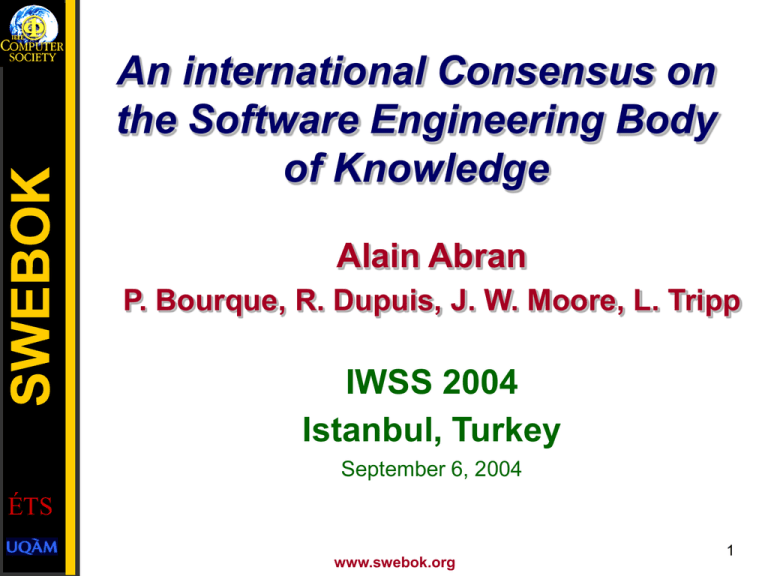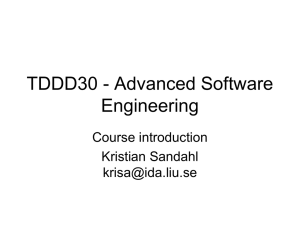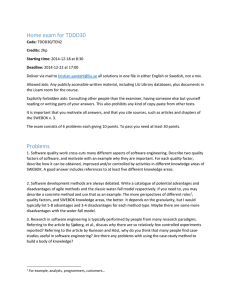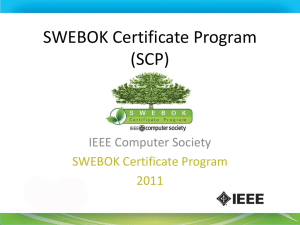SoftwareEngineeringBodyofKnowledge.ppt
advertisement

An international Consensus on the Software Engineering Body of Knowledge Alain Abran P. Bourque, R. Dupuis, J. W. Moore, L. Tripp IWSS 2004 Istanbul, Turkey September 6, 2004 ÉTS © IEEE www.swebok.org 1 Presentation Objectives Give an overview of this international consensus on the “core body of knowledge” of software engineering Briefly present the development process used to reach this consensus Briefly present usages of SWEBOK Guide Next steps Including links to System Engineering © IEEE www.swebok.org 2 Presentation Plan Project © IEEE background Project development process Contents of the Guide Usages of the Guide in organizations Next steps www.swebok.org 3 Guide to the Software Engineering Body of Knowledge (SWEBOK®) Project initiated by the IEEE CS International participation from industry, professional societies, standards bodies, academia, authors Over 500 hundred software engineering professionals have been involved Release of Ironman Version in 2004 ® Registered in U.S. Patent Office © IEEE www.swebok.org 4 Corporate Support by: Project managed by: © IEEE www.swebok.org 5 2004 SWEBOK Guide Endorsed by the project’s Industrial Advisory Board Approved by the IEEE Computer Society Board of Governors Adopted as ISO Technical Report 19759 Available on www.swebok.org To be published in book format by the IEEE Computer Society Press © IEEE www.swebok.org 6 SWEBOK Guide = 10 Knowledge Areas Mapped TO ISO/IEC 12207:1995 processes Requirements Design Construction Testing Maintenance Software Configuration Management Software Engineering Management Software Engineering Process Software Engineering Tools and Methods Software Quality Primary Processes © IEEE Supporting Processes www.swebok.org 7 What is Software Engineering? IEEE 610.12: “(1) The application of a systematic, disciplined, quantifiable approach to the development, operation, and maintenance of software; that is, the application of engineering to software. (2) The study of approaches as in (1).” © IEEE www.swebok.org 8 Recognized Profession? Starr*: Knowledge and competence validated by the community of peers Consensually validated knowledge rests on rational, scientific grounds Judgment and advice oriented toward a set of substantive values * © IEEE P. Starr, The Social Transformation of American Medicine: BasicBooks, 1982. www.swebok.org 9 Development of a Profession Initial professional education Accreditation Skills Development Professional societies One or both Certification Licensing Full Professional Status © IEEE Professional development Code of ethics www.swebok.org Adapted from Steve McConnell, After the Gold Rush, Microsoft Press, 1999, p. 93 10 Presentation Plan Project background Project © IEEE development process Contents of the Guide Applications of the Guide in organizations Next steps www.swebok.org 11 Project Objectives Characterize the contents of the Software Engineering Body of Knowledge Provide a topical access to the Software Engineering Body of Knowledge Promote a consistent view of software engineering worldwide © IEEE www.swebok.org 12 Project Objectives Clarify the place of, and set the boundary of, software engineering with respect to other disciplines (computer science, project management, computer engineering, mathematics, etc.) © IEEE Provide a foundation for curriculum development and individual certification and licensing material www.swebok.org 13 Intended Audience © IEEE Public and private organizations Practicing software engineers Makers of public policy Professional societies Software engineering students Educators and trainers www.swebok.org 14 What was out of scope? © IEEE Not a curriculum development effort Not an all-inclusive description of the sum of knowledge in the field Not all categories of knowledge www.swebok.org 15 Specialized Categories of Knowledge in the SWEBOK © IEEE Generally Accepted Advanced and Research Target of the SWEBOK Guide «Applicable to most projects, most of the time, and widespread consensus about their value and usefulness» Project Management Institute - PMI North American Bachelor’s degree + 4 years of experience www.swebok.org 16 Application domain knowledge Advanced SE Knowledge C.S. Specialized SE Knowledge Guide to the SWEBOK Stoneman Knowledge of a Software Engineer Maths ... © IEEE www.swebok.org 17 Three Underlying Principles of the Project Transparency: the development process is itself published and fully documented Consensus-building: the development process was designed to build, over time, consensus in industry, among professional societies and standards-setting bodies and in academia Available free on the web © IEEE www.swebok.org 18 Project Team © IEEE Editorial Team of the Guide Industrial Advisory Board Associate Editors of the Knowledge Areas Reviewers www.swebok.org 19 Roles of the Industrial Advisory Board © IEEE Provide input to ensure relevance to various audiences Review and approve strategy and deliverables Oversee development process Assist in promoting the Guide to the Software Engineering Body of Knowledge Lend credibility to the project www.swebok.org 20 A Three-Phase Approach for Developing the Guide Straw Man Phase Experimentation and Trial Usage Stone Man Phase Iron Man Phase (Sub-phase 1) Revision Iron Man Phase (Subphase 2) Trial Version 1998 © IEEE 1999 2000 2001 www.swebok.org 2004 Version 2002 2003 21 Version Review Process Transparency and consensus-building All intermediate versions of documents published and archived on www.swebok.org All comments made public as well as the identity of the reviewers Detailed comment disposition reports © IEEE www.swebok.org 22 Data on reviewers Trial Version Version 0,1: 33 Version 0,5: 195 Version 0,7: 378 + ISO reviews from 5 countries © IEEE www.swebok.org 23 Reviewers (2004 Version) © IEEE Years in the field 60 Number of Reviewers Registered reviewers: 573 Number of countries: 55 Number of comments: 1020 Number of reviewers submitting comments: 124 Number of represented countries: 21 + 7 countries submitted comments through ISO voting process Adopted by + 25 ISO participating countries 50 48 40 44 30 20 10 13 17 2 0 0-9 years 10-19 years 20-29 years 30-39 years 40-49 years Years in industry 50 45 Number of Reviewers 40 47 41 35 30 25 28 20 15 10 8 5 0 www.swebok.org 0-9 years 10-19 years 20-29 years 30-39 years 24 Project Overview Presentation Plan Project background Project development process Contents © IEEE of the Guide Applications of the Guide Next steps www.swebok.org 25 Deliverables: Consensus on a list of Knowledge Areas Consensus on a list of topics and relevant reference materials for each Knowledge Area Consensus on a list of Related Disciplines © IEEE www.swebok.org 26 Knowledge Areas and Related Disciplines Software Requirements Software Design Software Construction Related Disciplines • • Software Testing • Software Maintenance • Software Configuration Management • Software Eng. Management • • Software Eng. Tools & Methods • Software Engineering Process Software Quality © IEEE Computer Engineering Computer Science Mathematics Project Management Management Quality Management Software Ergonomics Systems Engineering www.swebok.org 27 Knowledge Area Description Classification of Topics Topic Descriptions © IEEE Matrix of Topics & References Classification by Vincenti’s Taxonomy Classification by Bloom’s Taxonomy References References to Related Disciplines Not implemented in Trial Version www.swebok.org 28 Guide to the Software Engineering Body of Knowledge 2004 Version Software Requirements Software Design Software Construction Software Requirements Fundamentals Software Design Fundamentals Basic Concepts of Construction Requirements Process Key Issues in Software Design Managing Construction Practical Considerations Software Testing Sofware Testing Fundamentals Test Levels Software Maintenance Software Maintenance Fundamentals Key Issues in Software Maintenance Maintenance Process Requirements Elicitation Software Structure and Architecture Requirements Analysis Software Design Quality Analysis and Evaluation Test Related Measures Requirements Specification Software Design Notations Test Process Requirements Validation Software Design Strategies and Methods Test Techniques Techniques for Maintenance Practical Considerations © IEEE www.swebok.org 29 Guide to the Software Engineering Body of Knowledge (2004 Version) Software Configuration Management Software Engineering Management Software Configuration Management Fundamentals Initiation and Scope Definition Keys Issues in SCM Software Configuration Control Software Configuration Status Accounting Process Implementation and Change Software Project Planning Process Definition Software Project Enactment Process Assessment Software Engineering Tools and Methods Software Tools Software Requirements Tools Software Design Tools Software Construction Tools Software Testing Tools Software Quality Related Disciplines Software Quality Fundamentals Computer Engineering Software Quality Management Processes Computer Science Practical Considerations Management Software Maintenance Tools Review and Evaluation Process and Product Measurement Software Engineering Process Tools Closure Software Engineering Management Tools Infrastructure Support Tools SW Engineering Measurement Mathematics Software Quality Tools Software Configuration Management Tools Software Configuration Auditing Software Release Management and Delivery Software Engineering Process Miscellaneous Tool Issues Project management Quality management Software Ergonomics Software Methods Heuristic Methods Systems engineering Formal Methods Prototyping Methods Miscellaneous Method Issues © IEEE www.swebok.org 30 Software Requirements Software Requirements Fundamentals Requirements Process Requirements Elicitation Requirements Analysis Requirements Specification Requirements Validation Practical Consideration Definition of Software Requirement Process Models Requirements Sources Requirements Classification System Definition Document Requirements Reviews Iterative Nature of Requirements Process Product and Process Requirements Process Actors Elicitation Techniques Conceptual Modeling Systems Requirements Specification Prototyping Change Management Functional and Non-functional Requirements Process Support and Management Architectural Design and Requirements Allocation Software Requirements Specification Model Validation Requirements Attributes Emergent Properties Process Quality and Improvement Requirements Negotiation Acceptance Tests Requirements Tracing Quantifiable Requirements Measuring Requirements System Requirements and Software Requirements © IEEE www.swebok.org 31 Software Quality Software Quality Fundamentals Software Quality Management Processes Software Engineering Culture and Ethics Software Quality Assurance Application Quality Requirements Value and Costs of Quality Verification and Validation Defect Characterization Models and Quality Characteristics Reviews and Audits Software Quality Management Techniques Software Quality Measurement Quality Improvement © IEEE Practical Considerations www.swebok.org 32 Summary of changes in 2004 Version Structural improvements in breakdown of topics: Software Construction, Management, Quality, Process Better representation of text in topic breakdown : Software Requirements, Testing, Maintenance Standardization of the contents of the chapters: topic breakdown, terminology, reference citations and writing style © IEEE www.swebok.org 33 Summary of changes in 2004 Version © IEEE Better representation of standards in chapters and a new Appendix devoted to standards Updating of reference material Handling of trial usage feedback Handling of reviewers comments New chapter on Related Disciplines (instead of an appendix) www.swebok.org 34 Presentation Plan Project background Project development process Contents of the Guide Applications of the Guide in organizations © IEEE Next steps www.swebok.org 35 Applications of the Guide Licensing & Certification IEEE CS CSDP exam and program Input in accreditation of software engineering programs in engineering faculties - CCPE Ordre des ingénieurs du Québec: Input to certify software engineers © IEEE www.swebok.org 36 Example Usages in Education Program Design/Assessment: National Technological University Monash University CRISTEL project Course Design/Assessment: A large number of universities École de technologie supérieure © IEEE www.swebok.org 37 Applications of the Guide Industry & Government Job description Bombardier Transportation Career planning Construx Input to Policy making Turkish Industry Survey © IEEE www.swebok.org 38 Applications of the Guide Professional development Security Industry Automation Corporation Construx Dissiminations of standards Introducing standards in software engineering curriculum © IEEE www.swebok.org 39 Presentation Plan Project background Project development process Contents of the Guide Usages of the Guide in organizations Next © IEEE steps www.swebok.org 40 Specialized Next steps: © IEEE Generally Accepted Advanced and Research Target of the SWEBOK Guide «Applicable to most projects, most of the time, and widespread consensus about their value and usefulness» Project Management Institute - PMI North American Bachelor’s degree + 4 years of experience www.swebok.org 41 Evolution process for the Guide © IEEE Copyright belongs to the IEEE Transition to self-supporting, volunteer-led process—i.e. self-funded. Coordination with related IEEE-CS projects (internal and external) Time-boxed block updates Involvement with stakeholder groups Openness and transparency Technical excellence www.swebok.org 42 Next Steps Research to strengthen the foundations of a body of knowledge: Vincenti’s classification of engineering knowledge Fundamental design principles Criteria and specifications Theoretical tools Quantitative data Practical considerations Design instrumentalities © IEEE Ontology of software engineering www.swebok.org 43 Next Steps Being investigated at ISO level: Certification of software engineers ISO standard on content of certification ISO recognized certifying bodies International portability of certification of software engineers © IEEE www.swebok.org 44 Next steps Consensus on the core body of knowledge is key in all disciplines and pivotal for the evolution toward a professional status INCOSE Building a System Engineering Body of Knowledge - SEBOK © IEEE www.swebok.org 45 www.swebok.org © IEEE www.swebok.org 46 Presentation Plan © IEEE Project background Project development process Contents of the Guide Usages of the Guide in organizations Next steps Appendix: Breakdown of topics www.swebok.org 47 Guide to the Software Engineering Body of Knowledge 2004 Version Software Requirements Software Design Software Construction Software Requirements Fundamentals Software Design Fundamentals Basic Concepts of Construction Requirements Process Key Issues in Software Design Managing Construction Practical Considerations Software Testing Sofware Testing Fundamentals Test Levels Software Maintenance Software Maintenance Fundamentals Key Issues in Software Maintenance Maintenance Process Requirements Elicitation Software Structure and Architecture Requirements Analysis Software Design Quality Analysis and Evaluation Test Related Measures Requirements Specification Software Design Notations Test Process Requirements Validation Software Design Strategies and Methods Test Techniques Techniques for Maintenance Practical Considerations © IEEE www.swebok.org 48 Guide to the Software Engineering Body of Knowledge (2004 Version) Software Configuration Management Software Engineering Management Software Configuration Management Fundamentals Initiation and Scope Definition Keys Issues in SCM Software Configuration Control Software Configuration Status Accounting Process Implementation and Change Software Project Planning Process Definition Software Project Enactment Process Assessment Software Engineering Tools and Methods Software Tools Software Requirements Tools Software Design Tools Software Construction Tools Software Testing Tools Software Quality Related Disciplines Software Quality Fundamentals Computer Engineering Software Quality Management Processes Computer Science Practical Considerations Management Software Maintenance Tools Review and Evaluation Process and Product Measurement Software Engineering Process Tools Closure Software Engineering Management Tools Infrastructure Support Tools SW Engineering Measurement Mathematics Software Quality Tools Software Configuration Management Tools Software Configuration Auditing Software Release Management and Delivery Software Engineering Process Miscellaneous Tool Issues Project management Quality management Software Ergonomics Software Methods Heuristic Methods Systems engineering Formal Methods Prototyping Methods Miscellaneous Method Issues © IEEE www.swebok.org 49 Software Requirements Software Requirements Fundamentals Requirements Process Requirements Elicitation Requirements Analysis Requirements Specification Requirements Validation Practical Consideration Definition of Software Requirement Process Models Requirements Sources Requirements Classification System Definition Document Requirements Reviews Iterative Nature of Requirements Process Product and Process Requirements Process Actors Elicitation Techniques Conceptual Modeling Systems Requirements Specification Prototyping Change Management Functional and Non-functional Requirements Process Support and Management Architectural Design and Requirements Allocation Software Requirements Specification Model Validation Requirements Attributes Emergent Properties Process Quality and Improvement Requirements Negotiation Acceptance Tests Requirements Tracing Quantifiable Requirements Measuring Requirements System Requirements and Software Requirements © IEEE www.swebok.org 50 Software Design 1. Software Design Fundamentals 2. Key Issues in Software Design 3. Software Structure and Architecture General design concepts Concurrency The context of software design Control and handling of events Architectural structures and viewpoints The software design process Distribution of components Architectural styles (macroarchitectural patterns) Enabling techniques Error and exception handline and fault tolerance Design patterns (microarchitectural patterns) Interaction and presentation 4. Software Design Quality Analysis and Evaluation Quality attributes Quality analysis and evaluation techniques 5. Software Design Notations Structural descriptions (static view) Behavior descriptions (dynamic view) Measures Families of programs and frameworks Data persistence 6. Software Design Strategies and Methods General Strategies Function-oriented (structured) design Object-oriented design Data-structrure centered design Component-based design (CBD) Other methods Figure 1 Breakdown of topics for the Software Design KA © IEEE www.swebok.org 51 Software Construction Basic Concepts of Construction Reduction of Complexity Managing Construction Construction Methods Construction Planning Role of Standards in Construction Construction design Coding Anticipation of Change Constructing for Validation Practical Considerations Construction Measurement Construction Testing Construction Quality Integration Construction Tools Construction Languages Figure 1. Breakdown of topics for the Software Construction KA. © IEEE www.swebok.org 52 Software Testing 1. Software Testing Fundamentals 2. Test Levels 3. Test Techniques 4. Test Related Measures Testing-Related Terminology The Target of the Test Based on tester's intuition and experience Evaluation of the Program Under Test Management Concerns Keys Issues Objectives of Testing Specificationbased Evaluation of the Tests Performed Test Activities Relationships of Testing to Other Activities 5. Test Process Code-based Fault-based Usage-based Based on nature of application Selecting and Combining Techniques © IEEE www.swebok.org 53 Software Maintenance Fundamentals Key Issues in Software Maintenance Maintenance Process Techniques for Maintenance Definitions and Terminology Technical Maintenance Process Models Program Comprehension Nature of Maintenance Management Maintenance Activities Re-engineering Need for Maintenance Maintenance Cost and Maintenance Cost Estimation Reverse Engineering Majority of Maintenance Costs Software Maintenance Measurement Impact Analysis Evolution of Soffware Categories of Maintenance © IEEE www.swebok.org 54 Software Configuration Management 1. Software Configuration Management Fundamentals Identifying Items to be Controlled Software Configuration Software Configuration Items Software Configuration Item Relationships Software Versions 2. Keys Issues in SCM 3. Software Configuration Control Organizational Context for SCM Constraints and Guidance for SCM Planning for SCM Requesting, Evaluating and Approving Software Changes SCM Organization and Responsibilities Software Change Request Process SCM Resources and Schedules Implementing Software Changes Acquiring Software Configuration Items Tool Selection and Implementation Vendor/ Subcontractor Control Software Library Interface Control Baseline Software Configuration Control Board 4. Software Configuration Status Accounting Software Configuration Status Information Software Configuration Status Reporting 5. Software Configuration Auditing Software Functional Configuration Audit Software Physical Configuration Audit 6. Software Release Management and Delivery Software Building Software Release Management In-Process Audits of a Software Baseline Deviations and Waivers Software Configuration Management Plan Surveillance of Software Configuration Management SCM Measures and Measurement In-Process Audits of SCM © IEEE www.swebok.org 55 Software Engineering Management Initiation and Scope Definition Software Project Planning Software Project Enactment Review and Evaluation Closure Determination and Negotiation of Requirements Process Planning Feasibility Analysis Process for Requirements Review/Revision SW Engineering Measurement Implementation of Plans Determining Satisfaction of Requirements Determining Closure Establish and Sustain Measurement Commitment Determine Deliverables Supplier Contract Management Reviewing and Evaluating Performance Closure Activities Plan the Measurement Process Effort, Schedule and Cost Estimation Implementation of Measurement Process Perform the Measurement Process Resource Allocation Monitor Process Evaluate Measurement Risk Management Control Process Quality Management Reporting Plan Management © IEEE www.swebok.org 56 Software Engineering Process Proces s Implementation and Change Proces s Ass es sment Life Cycle Models Process As sess ment Models Process Measurement Activities Software Life Cycle Process es Process As sess ment Methods Software Products Meas urement Models for Proces s Implementation and Change Notations for Process Definitions Quality of Meas urement Results Practical Considerations Process Adaptation Software Information Models Automation Process Measurement Techniques Process Infrastructure © IEEE Proces s and Product Meas urements Proces s Definition www.swebok.org 57 Software Engineering Tools and Methods I. Software Tools II. Software Methods Software Requirements Tools Heuristic Methods Requirements modeling Traceability Structured methods Data-oriented methods Object-oriented methods Software Design Tools Software Construction Tools Program editors Compilers Interpreters Debuggers Software Testing Tools Software Engineering Tools and Methods Domain specific methods Formal Methods Specification languages Refinement Verification Prototyping Methods Test generators Test execution frameworks Test evaluation Test management Performance analysis Styles Prototyping target Evaluation techniques Software Maintenance Tools Miscellaneous Method Issues Comprehension Re-engineering Method evaluation Software Engineering Process Tools Process modeling Process management Integrated CASE environments Process-centered software engineering environments Software Quality Tools Inspection Static analysis Software Configuration Management Tools Defect, enhancement, issue and problem tracking Version managment Release and build Software Engineering Management Tools Project planning and tracking Risk management Measurement Infrastructure Support Tools Interpersonal communication Information retrieval System administrative and support Miscellaneous Tools Issues Tool integration techniques Meta tools Tool evaluation © IEEE www.swebok.org 58 List of Knowledge Areas Software Requirements Software Design Software Construction Software Testing Software Maintenance Software Configuration Management Software Quality Software Engineering Tools & Methods Software Engineering Process Software Engineering Management © IEEE www.swebok.org 59 Formal resolutions Industrial Advisory Board (2001) IEEE CS Board of Governors (2001) "The Board of Governors of the IEEE Computer Society accepts the Guide to the Software Engineering Body of Knowledge (Trial Version) as fulfilling its development requirements and is ready for field trials for a period of two years“ IEEE CS Board of Governors (Feb. 2004) Officially approved the 2004 Version © IEEE ISO Technical Report 19759 (upcoming) www.swebok.org 60 Trial Version Review Process Version 0.1 Limited number of domain experts Review Cycle 1 Selected users Version 0.5 Review cycle 2 Community Version 0.7 Review Cycle 3 Version 0.9 © IEEE www.swebok.org 61 Trial Version (2001) © IEEE www.swebok.org 62 © IEEE www.swebok.org 63 Comment Resolution © IEEE www.swebok.org 64 Geographic Distribution of Reviewers Trial Version USA: 55% Europe: 18% 90 reviewers from 25 countries © IEEE Canada: 10% Australia: 5% Asia: Latin America: 4% 5% www.swebok.org 65 Education level of reviewers (Version 0,7) 3% 24% 34% 39% © IEEE www.swebok.org Ph.D. Masters Bach Other 66 Number of employees at reviewer location (Version 0,7) 31% 37% 0-50 50-500 Over 500 32% © IEEE www.swebok.org 67 Number of years of practical experience (Version 0,7) 9% 32% 21% 0-9 38% 10-19 20-29 Over 30 © IEEE www.swebok.org 68


